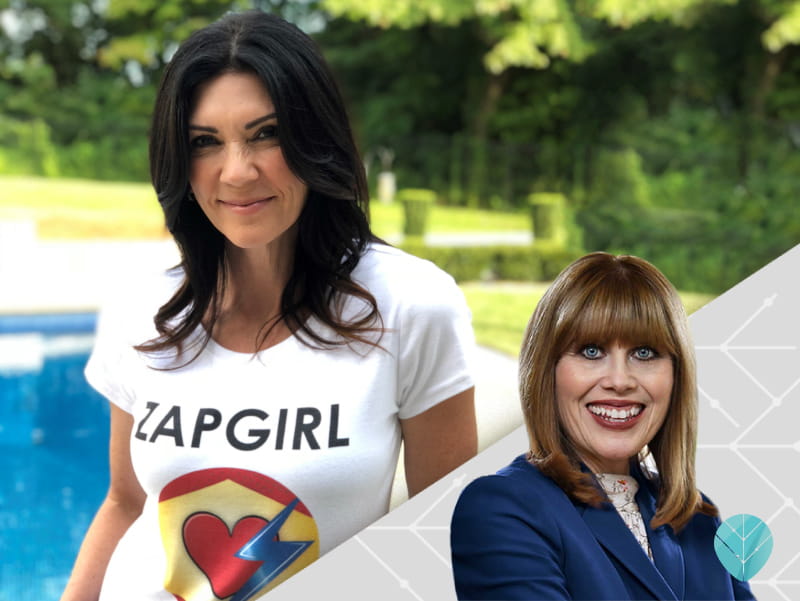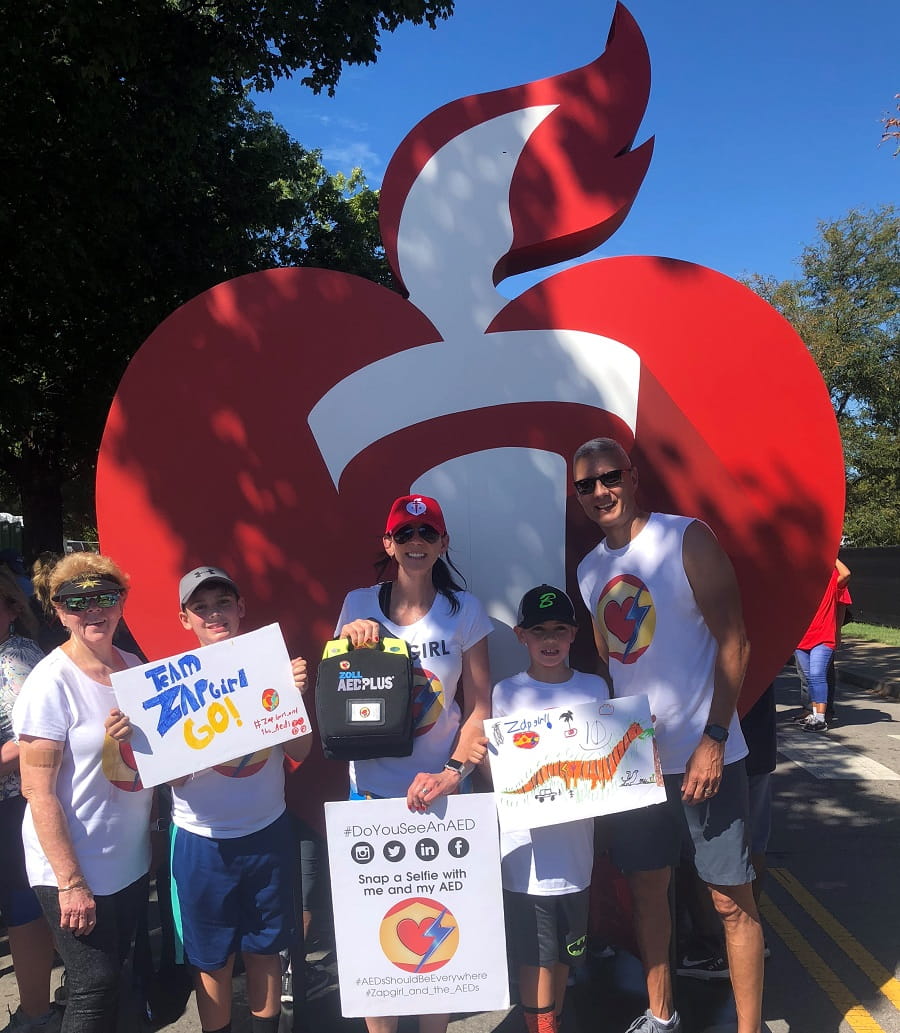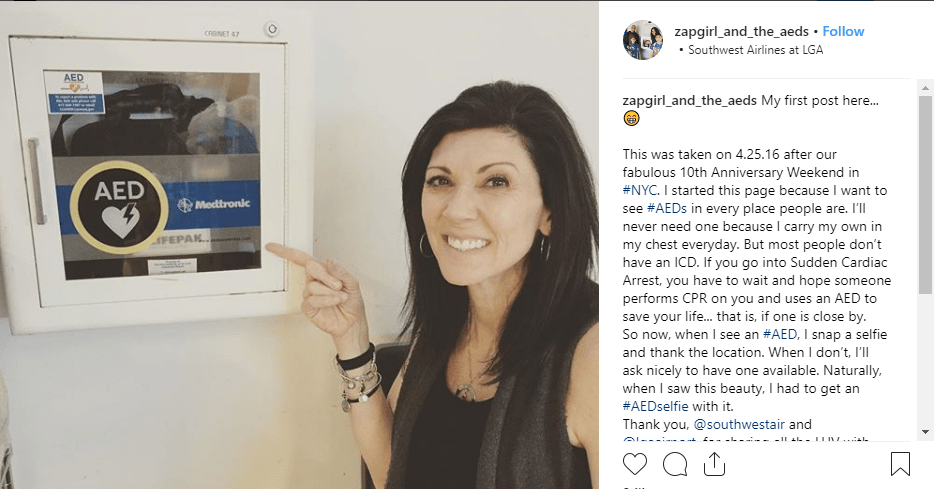Look! It's a lifesaving device! Time to send a selfie to Zapgirl!
By Nancy Brown, American Heart Association CEO

Every superhero needs a purpose, preferably one stemming from their origin story. A catchy name helps. A cool logo is great for marketing.
And, in 2018, a vibrant social media presence is a must.
Zapgirl has it all.
What? You haven’t heard of her?
Zapgirl’s superpower is drawing attention to AEDs, devices that can zap a stopped heart back to life. Hopefully you’re accustomed to seeing these machines in a box mounted on a wall, near a sign that reads AED and features a heart with a lightning bolt.
The only skill required to use an AED is knowing where it is, which is why awareness is everything. So a few years ago, a woman from Nashville started taking selfies with AEDs.
In February, she shifted into her alter ego of Zapgirl and asked everyone on the internet to become AED spotters. She urged them to send selfies with AEDs that she would share via Instagram(link opens in new window), Twitter(link opens in new window), Facebook (link opens in new window)and her website(link opens in new window).
Those feeds are now filled with images of AEDs in offices and gyms, stadiums and airports, beaches and trains, churches and malls. They’ve come from California, Colorado, Georgia, Hawaii, Minnesota, Ohio and Utah … as well as Brazil, Canada, Denmark, England, Faroe Islands, Israel, South Africa, South Korea, Spain and Uruguay. Even the Leaning Tower of Pisa in Italy.
More are in her inbox, waiting to be posted. After all, she’s just one person: Carrie Romero. And as delightful and inspiring as her campaign is, the story behind it is even better.

***
It starts, of course, with the origin story.
Carrie was 22 when she felt like daggers were digging into both sides of her chest. It turned out to be a mostly harmless glitch in her heart’s plumbing. It was resolved with medicine.
When it happened again, several times, around her 28th birthday, she figured a few pills was all she needed.
But a cardiologist discovered that in addition to the original diagnosis of mitral valve prolapse, she had an enlarged heart and another issue causing extra beats. To better grasp it all, he needed to perform a test that involved sending electric pulses into her heart.
On the first pulse, her heart stopped.
The test ended, of course, and Carrie was hospitalized for several days as the doctor sought the best way to control her heart’s electric circuitry.
What she needed, he thought, was a device called an implantable cardioverter defibrillator, or ICD. Sewn into the body, with wires connected to the heart, an ICD provides constant monitoring – and when it detects an abnormal rhythm, a jolt of electricity is delivered to get things back in sync.
These are frequently used today. But in 1997, when Carrie was in the hospital, it was so rare for someone so young to get an ICD that her doctor consulted with experts around the country to make sure she was eligible.
Following the procedure, Carrie had to adjust to the fact that at 28 she not only had multiple heart problems, she had a machine in her chest helping to keep her alive.
She went into a psychological coma. She sought solace from a support group. But when a sweet elderly man greeted her by asking if she was accompanying one of her grandparents, her emotional funk deepened.
About the only thing that made Carrie smile was the nickname coined by her sister: Zapgirl.
***
Carrie’s turnaround began by adopting a rescue dog, a lovable Catahoula mix puppy that had to be walked every day.
The ICD never went off during those walks, proving to Carrie that she could trust her body. Eventually, her mood lifted.
She moved to Orlando, Florida, to be close to family and to pursue a lifelong dream: performing at Walt Disney World.
She got the gig. Dressed as fairytale royalty, Carrie appeared on Cinderella’s Castle Stage alongside Mickey Mouse, Goofy, Peter Pan and more.
At the end of her debut show, she ran down the breezeway for a private moment.
“Yes!” she told herself. “I did it! Amazing!”
As she pulled down her right arm in a victorious fist pump, her chest violently thrust forward. She looked around for fireworks that might have gone off nearby or even hit her. Did something in the breezeway electrocute her?
“Then it dawned on me,” she said. “I just got my first shock. That just saved my life.”
She called her doctor to see what to do next.
“Nothing,” he said. “That’s exactly why you have it.”
Carrie responded by embracing being alive. After work one night, she rode the Rock ‘n’ Roller Coaster over and over.
***
In November 2005, while still working at Walt Disney World, she met her real-life Prince Charming, Gus Romero. They married, then left Florida in 2007, moving for Gus’s career, coincidentally to Nashville.
No longer working and now cooking a lot more, she started slowly gaining weight. Eventually, she started running – just down the street and back at first.
Months later, she and Gus ran a 5K. Crossing the finish line with tears streaming, she embraced the first person she saw and said, “I ran without stopping and have a defibrillator in my chest!”
Days later, Carrie took their two dogs out for a walk on a country road. She was thrown to the ground as if kicked by a mule. Realizing this was her ICD going off, she put a hand over it. Another jolt followed, marking the first time an episode required multiple shocks.
“This is not going to be the end of me,” she told herself. “This is NOT the end!”
As with the Castle episode, walking away from nearly dying felt empowering.
Two months later, she learned she was pregnant.
***
Within a year after delivering her second child – both boys, Cason and Trevin – Carrie began feeling as if she were going to pass out.
The problem, it turned out, was her medicine. She no longer needed any.
“I’d run myself to good health,” she said, beaming.
Carrie is on her fifth ICD now, getting advanced technology every time she needs a new battery. A few years ago, she shared her story with her device maker, Medtronic, and was invited to Minnesota as a Global Hero for the Twin Cities Marathon Weekend, which the company sponsors.
She ran a 10-mile event and returned for several years as a host for new ambassadors. In January, she and Gus met Earl Bakken, the company’s founder and creator of the external, wearable pacemaker.
“Thank you for your vision and for the technology that helped save my heart,” she told him.
***
On her first trip from Nashville to Minneapolis, Carrie noticed AEDs at both airports.
She felt a bond between the lifesaving devices and the one inside her. She took selfies with them for the irony and came away with a nagging sense that she could do more.
It was the same nagging sense she and Gus felt about the “Zapgirl” nickname. For the last 20 years, she’d only used it as part of her email address. They’d long thought it could serve a larger purpose, but they didn’t know how.
In February, Carrie served as a spokesperson for my organization, the American Heart Association, for a TV story about a Nashville businessman saved by an AED at work. Carrie asked to take a selfie in front of the AED that saved his life.
“This,” she realized, “is what I’m supposed to do with Zapgirl.”
Days later, she launched an Instagram account with the following post:

Zapgirl has two aims:
1. Getting more AEDs in public places.
- “You always see fire extinguishers to protect buildings. But what about protecting the people in them? I want to see an AED next to every fire extinguisher.”
2. Getting more people to use them.
- “Think of an AED as jumper cables for a heart. They are just as easy to use. Grab it off the wall, turn it on and it tells you what to do.”
***
World Heart Day(link opens in new window) is Sept. 29, and it’s the World Heart Federation’s biggest platform for encouraging people to think more about cardiovascular diseases, including heart disease and stroke. This year’s theme is “My Heart, Your Heart,” an emphasis on looking after our own hearts and the hearts of our loved ones.
It’s what Zapgirl/Carrie does every day.
So to commemorate World Heart Day, I encourage you to snap a selfie with an AED and share it with Carrie. She’s planning to get maps of the United States and the world, and to have her sons mark every place a selfie comes from; let’s help them fill those maps.
“The most beautiful thing about this is that it’s not me – it’s a collective unit of people looking to save lives,” she said. “No matter what circumstances anyone is facing, your circumstances shouldn’t dictate who you are or what you do with the rest of your life.
“I hope people read this and say, 'If she can do all that she’s done, there’s hope for me.’”
A version of this column also appeared on Thrive Global.
If you have questions or comments about this story, please email [email protected].





